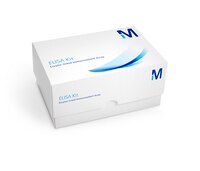17-483 Sigma-AldrichInsulin Receptor (β subunit) STAR ELISA Assay Kit
This Insulin Receptor (β subunit) STAR ELISA Assay Kit is used to measure & quantify Insulin levels.
More>> This Insulin Receptor (β subunit) STAR ELISA Assay Kit is used to measure & quantify Insulin levels. Less<<Recommended Products
Overview
| Replacement Information |
|---|
Key Spec Table
| Analytes Available | Species Reactivity | Key Applications | Detection Methods |
|---|---|---|---|
| Insulin | H, M, R | ELISA | Chromogenic |
| References |
|---|
| Applications | |
|---|---|
| Application | This Insulin Receptor (β subunit) STAR ELISA Assay Kit is used to measure & quantify Insulin levels. |
| Key Applications |
|
| Physicochemical Information | |
|---|---|
| Sensitivity |
|
| Dimensions |
|---|
| Materials Information |
|---|
| Toxicological Information |
|---|
| Safety Information according to GHS |
|---|
| Safety Information |
|---|
| Packaging Information | |
|---|---|
| Material Size | 96 assays |
| Transport Information |
|---|
| Supplemental Information |
|---|
| Specifications |
|---|
| Global Trade ITEM Number | |
|---|---|
| Catalogue Number | GTIN |
| 17-483 | 04053252330056 |
Documentation
Insulin Receptor (β subunit) STAR ELISA Assay Kit Certificates of Analysis
| Title | Lot Number |
|---|---|
| STAR Insulin Receptor (beta; subunit) ELISA Kit - manual | manual |
Technical Info
| Title |
|---|
| 96 well Template 2 Up |
| 96 well Template Single |








